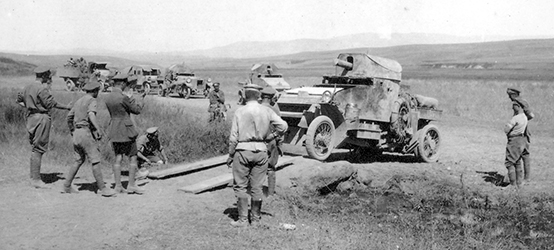Cromer Servicemen and Servicewomen in the First World War
Click on the button for a listing of all the servicemen and servicewomen from Cromer in the First World War that we have currently identified. Use the other grey buttons below if you wish to look at a subset of these men and women. There are notes on the construction of this listing at the bottom of the page.
The Cromer Post, the local newspaper, listed members of the . The newpaper also listed members of the .  Cromer men of the Territorials, probably taken at Colchester soon after they had been called up.The Territorial Army was formed in 1908. The 5th Territorial Battalion of the Norfolk Regiment drew its men from across the county; there were eight Companies with 'F' company recruiting from Cromer, with detachments at Melton Constable, Sheringham and Holt.
Cromer men of the Territorials, probably taken at Colchester soon after they had been called up.The Territorial Army was formed in 1908. The 5th Territorial Battalion of the Norfolk Regiment drew its men from across the county; there were eight Companies with 'F' company recruiting from Cromer, with detachments at Melton Constable, Sheringham and Holt.
The was another grouping used by the Cromer Post, as was . Kitchener's Army was that group of men who volunteered in response to the appeals more more men at the beginning of the war. was a further section identified by the newspaper. The Yeomanry Regiments were part of the reserve forces. There were three Norfolk Yeomanry regiments.
The M.P. Oliver-Locker Lampson, who had a family home at Newhaven Court in Cromer, received a commission in the R.N.V.R. on an understanding with Winston Churchill that he would fund the establishment of an armoured car squadron. He commanded the squadron and recruited a number of Cromer men as part of his command. The details of Cromer men in the have been added from other information sources, principally newspapers later in the year.

A number of men are listed in the newspaper as serving in the - and there is one entry for a woman. However, we have not been able to establish that women served in the actual R.A.M.C during World War One, so she might have been in one of the Voluntary Aid Detachments, in Queen Alexandra's Imperial Military Nursing Service (QAIMNS) or the Territorial Force Nursing Service (TNS).
We are taking the newspaper's reference to the to refer to those men who were on a register which was maintained by Territorial Force County Associations; these men had military experience, but no other reserve obligation.
The local newspaper the Cromer Post referred to one group as the . This probably refers to members of the Canadian Expedionary Force. Canada did not call up its militia on the declaration of war but sent volunteers; as several young men of Cromer had emigrated to Canada, they seem to have willing returned on the outbreak of war. As can be seen, some of the units used Scottish style dress, including the kilt.
 Men of the Canadian Volunteers; Alfred Salter, second right, had grown up in Cromer
Men of the Canadian Volunteers; Alfred Salter, second right, had grown up in Cromer
Clicking on the button will select just those men who died in the course of service, the majority by enemy action but some through illness and some through accident. It is these names which appear on the war memorial at Cromer and in the book on the memorial under the tower in Cromer parish church.
Notes on the Database
The initial database is based on the listing of Cromer and Suffield Park men compiled for the Cromer Post in January 1915. We believe there will be many more names to add and we hope you will assist with this.
The military divisions, e.g. Royal Navy, Kitchener's Army, Norfolk Imperial Yeomanry, are broad distinctions, based on those 1915 newspaper records. They are not specific military distinctions such as Brigades and Divisions. We plan to develop some further information pages on the different units.
At the time of writing, just one of those listed is female. With Cromer's war memorial being one of the very few nationally with a female figure, the database has been designed to have female entries as well, but information is sadly lacking at present on the service of women.
In the individual records, the person's year of birth may be given. If this is calculated from the age given in one of the censuses, there may be an error of one year, depending on when the person's birthday falls in the year.

